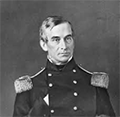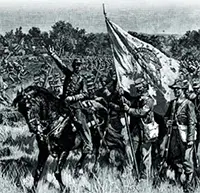The American Civil War
Part 1: The War Begins It was on April 12, 1861, that the first shots in anger were fired in the American Civil War. The target was Fort Sumter, owned by the United States Army but on that day technically still U.S. property but surrounded by land that was part of the Confederate States of America. South Carolina, on Dec. 20, 1860, had become the first state to secede from the Union. Another six states–in order, Mississippi, Florida, Alabama, Georgia, Louisiana, and Texas–had followed, and those seven states formed the Confederate States of America on Feb. 8, 1861. So in political terms, Fort Sumter was an island. In a sense, the conflict was the military version of a widespread and deep-seated disagreement that had been a long time coming. The issue of slavery had divided the country for most of its history. Also wrapped up in the identity of many of those who had wrenched themselves free from Great Britain was the idea that a state was a sovereign entity, perhaps even moreso than a country. Decades of events had highlighted the differences between North and South, even as the West opened up to settlement for both. The road to the Civil War was a long and winding one, but it eventually led to a conflict that could no longer be solved compromise. 
The commander of the Union garrison was Major Robert Anderson (left), who arrived at Fort Sumter only on Nov. 15, 1860. A Kentucky native and onetime slaveholder, Anderson arrived first at Fort Moultrie, also in Charleston Harbor, and set about improving that fort's defenses. Anderson arrived before South Carolina had officially left the Union. When that secession occurred, he ordered his men to abandon Fort Moultrie and take cover inside Fort Sumter. 
In March, the Confederate States of American produced a constitution that was a blueprint for a new government. Newly elected Confederate President Jefferson Davis appointed Brigadier General P.G.T. Beauregard (right) to lead the siege. On the night of April 11, Confederate leaders gave Anderson a one-hour warning that they were intending to fire on the fort, and then they did so, starting at 4:30 a.m. on April 12. Firing the first shot was Edmund Ruffin of Virginia. The firing continued intermittently for 34 hours, firing in all more than 3,000 shells. The following day, Lincoln issued a call for 75,000 volunteers to fill the ranks of the Union Army. Four days later, Virginia seceded from the Union; and the following day, Robert E. Lee refused an offer from President Abraham Lincoln to command the Union armies. Instead, Lee resigned his U.S. Army commission and offered his services to the Confederacy. Instead, Lincoln appointed as his top commander Mexican-American War hero Gen. Winfield Scott; together, the two announced a Union blockade of all Southern ports. Arkansas and North Carolina in May 1861 seceded from the Union and joined the Confederacy. Tennessee was the last state to do so, in June. Significantly, the so-called "Border States"–Delaware, Kentucky, Maryland, and Missouri–did not, at any time throughout the war. The Confederate and Union armies clashed at various places in the East and West for a time. The first major battle took place near the Virginia town of Manassas and the river known as Bull Run. On July 22, the two armies clashed in the First Battle of Bull Run/Manassas. The Union had the larger army, but those soldiers were mostly raw recruits. However, during the battle, the Confederate troops suffered from communication problems. Commanders on both sides tried to execute complex battle plans that fell apart in the heat of live fire. 
As well, one of the most famous episodes of the war took place on this day. One of the colonels commanding troops for the Confederacy that day was Gen. Thomas Jackson. He was on Henry House Hill and held off attack after attack by the Union troops. Another commander, Barnard Bee, saw how Jackson, sitting atop his horse, appeared unperturbed at the chaos whirling around him. Hoping to rally his men, Bee shouted at them, "There stands Jackson like a stone wall! Rally behind the Virginians!" Jackson thereafter was known as Stonewall Jackson. It was Jackson's men as well who were the first to utter the high-pitched screams that came to be known as the Rebel Yell. The result that day was a rout, a clear victory for the Confederacy. Union soldiers sped back toward Washington, D.C. Also fleeing the area were the dozens of Northern "observers" who, so assured of a Union victory, had laid out a picnic nearby. The observers included some members of Congress. Next page > McClellan Ascendant > Page 1, 2, 3, 4, 5, 6, 7, 8, 9, 10 |
|
Social Studies for Kids
copyright 2002–2024
David White




